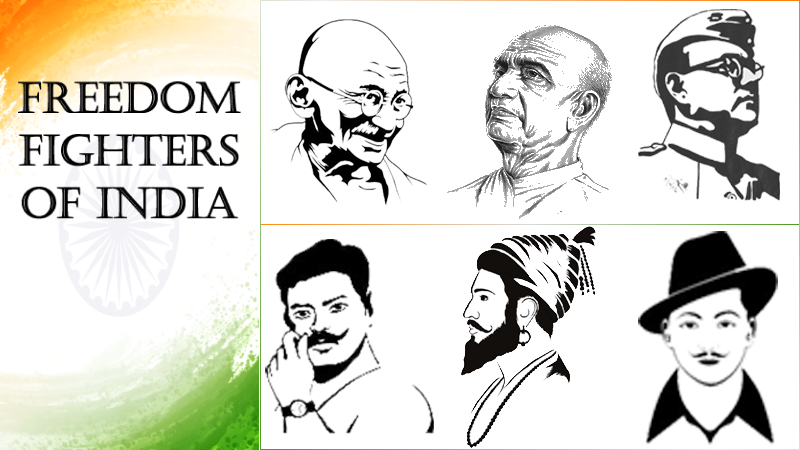Our Nation
India’s freedom wasn’t handed over on a silver platter. It was earned- through sweat, sacrifice, and sheer determination. Brave men and women stood up against British rule, knowing well that their fight could cost them their lives.
Today, our children grow up in a free India. But do they know the real struggles behind this freedom? As parents, we teach them values like courage and honesty. What better way than by sharing the stories of famous freedom fighters who shaped our nation?
Let’s go back in time and meet these Indian freedom fighters.
Early Freedom Fighters of India (Before 1857)
- Mangal Pandey (1827–1857) – The First Spark of Rebellion
A soldier who refused to follow orders blindly. When Mangal Pandey defied the British in 1857, it wasn’t just about a rifle cartridge—it was about dignity. His rebellion triggered the First War of Independence, making him a symbol of defiance.
- Rani Lakshmibai (1828–1858) – The Warrior Queen of Jhansi
The British thought a young widow would surrender easily. They were wrong. Lakshmibai fought with unmatched bravery, charging into battle with her infant son strapped to her back. Her war cry—”Main apni Jhansi nahi doongi”—still echoes in history.
- Tatya Tope (1814–1859) – The Master of Guerrilla Warfare
He didn’t believe in fighting fair. Tatya Tope kept British forces on edge with his swift, unpredictable attacks. Even when outnumbered, he fought till his last breath, refusing to let British rule go unchallenged.
Key Leaders of the Indian Freedom Struggle (1857–1947)
- Mahatma Gandhi (1869–1948) – The Father of the Nation
A man who fought without raising a sword. Gandhi’s philosophy of non-violence and civil disobedience made the British tremble. He turned salt into a symbol of resistance and silence into the loudest protest.
- Subhas Chandra Bose (1897–1945) – The Leader of the Indian National Army
If Gandhi was the peaceful protester, Bose was the fiery warrior. “Give me blood, and I will give you freedom,” he declared. He built an army, sought international allies, and refused to settle for anything less than complete independence.
- Bhagat Singh (1907–1931) – The Revolutionary Martyr
At just 23, Bhagat Singh became a legend. He believed that revolution wasn’t just about protests and shaking the foundation of oppression. His fearless sacrifice made him immortal.
- Sardar Vallabhbhai Patel (1875–1950) – The Iron Man of India
India’s unifier. After independence, it was Patel who ensured that over 500 princely states joined the Indian Union. Without him, the map of India might have looked very different today.
- Dr. B.R. Ambedkar (1891–1956) – Architect of the Indian Constitution
More than just a freedom fighter, Ambedkar was a visionary. He gave India its constitution, ensuring justice, equality, and dignity for all.
Women Freedom Fighters of India
- Sarojini Naidu (1879–1949)
The Nightingale of India. A poet, politician, and fierce advocate for civil rights, she was the first woman president of the Indian National Congress.
- Kasturba Gandhi (1869–1944) – A Silent yet Strong Leader
While Gandhi led the movement, Kasturba stood beside him, leading protests and spreading awareness among women. She proved that strength isn’t always loud—it’s consistent, determined, and unwavering.
These lady freedom fighters remind us that courage and leadership have no gender.
Major Movements That Led to Independence
- Swadeshi Movement (1905–1911): A call to boycott British goods and embrace Indian-made products. It was a movement of self-reliance and pride.
- Non-Cooperation Movement (1920–1922): Led by Gandhi, it urged Indians to withdraw from British institutions, schools, and courts.
- Quit India Movement (1942): A decisive call for the British to leave India. It marked the final push for freedom, uniting the nation like never before.
Frequently Asked Questions (FAQs)
- Who is called the Father of India’s Independence?
Mahatma Gandhi is called the Father of India’s Independence for leading the non-violent struggle against British rule.
- Who were the top five freedom fighters of India?
The top five famous freedom fighters were Mahatma Gandhi, Subhas Chandra Bose, Bhagat Singh, Sardar Patel, and Dr. B.R. Ambedkar.
- What were the main causes of the Indian independence movement?
Unfair British policies, heavy taxation, economic exploitation, and a growing desire for self-rule led to India’s fight for freedom.
- When did India gain independence?
India gained independence from British rule on August 15, 1947, after decades of struggle by historical freedom fighters.
The Legacy Lives On
Our children don’t have to fight for freedom. But they should know what it took to get here. The struggles, the sacrifices, the heroes who gave us this life. At Chrysalis Kids, one of the best kindergarten schools in Bangalore, we believe in teaching children these values through stories and experiences. Just like these historical freedom fighters, children need courage, creativity, and critical thinking to shape the future.
If you’re looking for a school that nurtures creativity, curiosity, and critical thinking, visit Chrysalis Kids, one of the leading pre-nursery schools in Bangalore. Let’s work together to raise thoughtful, informed, and courageous individuals.
